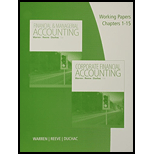
Concept explainers
Accounts receivable refers to the amounts to be received within a short period from customers upon the sale of goods and services on account. In other words, accounts receivable are amounts customers owe to the business. Accounts receivable is an asset of a business.
Bad debt expense is an expense account. The amounts of loss incurred from extending credit to the customers are recorded as bad debt expense. In other words, the estimated uncollectible accounts receivable are known as bad debt expense.
Direct write-off method:
This method does not make allowance or estimation for uncollectible accounts, instead this method directly write-off the actual uncollectible accounts by debiting bad debt expense and by crediting accounts receivable. Under this method, accounts would be written off only when the receivables from a customer remain uncollectible.
To journalize: The collection of $1,200 cash and write-off of Person M’s $4,000 uncollectible accounts, using direct write-off method.
Want to see the full answer?
Check out a sample textbook solution
Chapter 8 Solutions
Working Papers, Volume 1, Chapters 1-15 for Warren/Reeve/Duchac's Corporate Financial Accounting, 13th + Financial & Managerial Accounting, 13th
- provide solution of this question with financial accounting methodarrow_forwardSubject: Financial Accounting-The Banner Income Fund's average daily total assets were $100 million for the year just completed. Its stock purchases for the year were $20 million, while its sales were $12.5 million. What was its turnover?arrow_forwardWhat is the total gross profit margin for the month?arrow_forward
- What is the estimated percentage increase in net income general accounting question increase in sale?arrow_forwardWhat is the depreciation expense for 2022arrow_forwardBlueTech Corporation's balance sheet reports Assets of $8,400, Contributed Capital of $4,500, and Retained Earnings of $600. What is the total amount of liabilities on the balance sheet? a. $12,900 b. $3,300 c. $3,600 d. $8,100 e. None of the abovearrow_forward
- Century 21 Accounting Multicolumn JournalAccountingISBN:9781337679503Author:GilbertsonPublisher:Cengage

